Publications
There are 13 results.
PHÄLIKS - The Phenomenon of driving left on multi-lane motorways - Measures and recommendations for the rule of keeping to the right side of the road

Within this study the phenomenon of driving on the left side on motorways was described and analysed with psychological, traffic related, juridical and sociological methods. Based on these results adequate measures were developed; these should enhance or facilitate the proper compliance with the traffic rules in Austria, which is driving on the right side of the road. Experts from relevant fields of expertise and competence (traffic, landscape, sociology etc.) accompanied the whole process by giving their inputs, evaluating the results of the exploration of the driving-left issue, and prepared and optimised the practical output of the project.
Dr. Christine Chaloupka-Risser, Dipl.-Ing. Dr. Wolfgang J. Berger, Mag. Martin Hoffer, Dipl.-Ing. Ulrike Raich, Mag. Doris Wunsch, Mag. Karin Ausserer, Bakk.techn. Thomas Rothberger
Publisher: BMVIT
German, 277 pages
Publication Downloads
OBESTO – Implementation of the user oriented and Life Cycle Costing approach in the Austrian design method for upper road structures
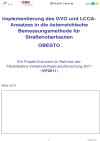
Within this project, performance-based material behaviour of Hot Mix Asphalt (HMA) was implemented in the Austrian design approach. Considering actual asphalt mechanic behaviour, as well as specific traffic loads and climatic conditions, the structural technical life time of road pavements with different bitumen, bitumen systems and mix design could be determined and considered in the design process. In addition, a standardized life-cycle cost analysis helped to evaluate and identify the economic differences between alternative pavement types. The results of this project should be the basis for a complete revision of the Austrian pavement design standard, RVS 03.08.63.
Univ.-Prof. DI Dr Ronald Blab, DI Lukas Eberhardsteiner, DI Katrin Haselbauer, DI Bettina Marchart, DI Torsten Hessmann
Publisher: BMVIT
German, 147 pages
Publication Downloads
OdimAk – Optimized dimensioning procedure for highway interweavings
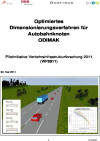
The project ODIMAK dealt with a new capacity analysis method for multi-level intersections based on existing guidelines. Measurements of complex weaving procedures on the ASFINAG network were taken into account. A microscopic traffic simulation tool was applied to develop an analysis method for multiple weaving segments. The traffic flow model was calibrated using the previous measurements. Typical geometrical settings were defined and modeled. The simulation results are taken for regression analysis to identify suitable dimensioning procedures, which were discussed within the FSV committee on intersections.
DI Michael Cik, Prof. Dr.-Ing. Martin Fellendorf, DI Roland Fenzl, DI Erich Gaube, DI Dr. techn. Georg Kriebernegg
Publisher: BMVIT
German, 100 pages
Publication Downloads
RELSKG - Developement of a simplified method of calculations for noise protection walls with complex geometry
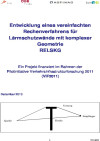
The aim of the project was to determine correction factors for noise barriers with complex geometries to be used in the ray-tracing method based on numerical simulations with the boundary element method. The results of the simulations were validated by measurements. Complex geometries of the noise barriers included barriers with more than one refraction edge and curved geometry. The expected correction factors allow the implementation of the results in standard calculation software used in practice.
Dr. Holger Waubke, Dr. Christian Kasess, DI Heinz Hoislbauer, Ing. Gerhard Strohmayr, Dipl. Phys. Dieter Zollitsch
Publisher: BMVIT
German, 147 pages
Publication Downloads
RAIL-SLEEPER - New impregnating agents for wooden railway sleeper

In this project products with a better toxicological profile than creosote are under examination as alternatives for the impregnation of wooden railway sleepers. The demanded key properties have to be geared to those shown by creosote: high biological efficacy, long service-life, no increase of corrosion, low conductivity of impregnated sleepers and high resistance against physical and chemical stress.
Mag. Notburga Pfabigan
Publisher: BMVIT
German, 47 pages
Publication Downloads
OPTIWALL - Inverse optimization of noise barrier dimensioning
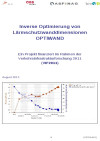
This project developed a method to find the optimal solution for the planning of noise barriers regarding financial costs and effect.
Ao.Univ.-Prof. DI Dr. Christian Kirisits, Géza Horváth, Dr.-Ing. Ilias Sachpazidis, Dipl.-Ing. Thomas Drewes
Publisher: BMVIT
German, 87 pages
Publication Downloads
Combined fibre concrete – Development of a crack-free railway sleeper through the use of a combined fiber-reinforced high-strength concrete
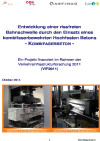
In practice the use of pre-stressed concrete sleepers is often accompanied by cracks-occurrence, such as longitudinal, lateral and shrinkage cracks. At the occurrence of cracks the resistance of sleepers to environmental influences is reduced.By the development of a combined fibre reinforced high-strength concrete, the risk of a formation of micro- and macro cracks can be substantially reduced, whereby the expected lifetime of concrete sleepers can increasing significantly and a costly renovation can be avoided.
Dr.- Ing. Sandro Weisheit, Dipl.-Ing. Gregor Metzler
Publisher: BMVIT
German, 85 pages
Publication Downloads
Frame bridge – Handling instruction for the conversion from existing bridges to integral bridges
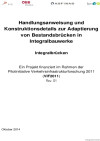
The objective of this project was the elaboration of the handling instruction for the adaptation of conventional existing bridges to integral bridges by means of a survey of the national and international literature as well as statistical examination taking essential parameters into account. In addition to the essential construction details of the integral or semi-integral bridges (e.g., frame corner and concrete hinge) the deformable slip plate will also be examined and design rules will be suggested.
O. Univ.-Prof. Dr.-Ing. habil. Nguyen Viet Tue, Dipl.-Ing. Regina della Pietra, Dipl.-Ing. Stefan Oberwalder et al.
Publisher: BMVIT
German, 332 pages
Publication Downloads
MANEUVER - Development of avoidance measures for misconduct on railway crossings with the aid of the traffic psychology
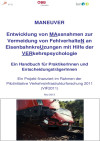
The objective of the project was to develop cost-effective measures (education, awareness-raising, roadside infrastructure) with the help of experts and road traffic participants to reduce misdemeanour at level crossings. Traffic psychological research methods will be adopted.
Mag. Eva Aigner-Breuss, DI Michael Aleksa, Dr. Eveline Braun, DI Klaus Machata, et al.
Publisher: BMVIT
German, 131 pages
Publication Downloads
LARA - Low noise tyres for quiet streets
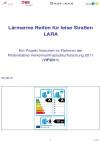
The objective of the project was to apply the EU regulations 2009/661/EC (contains new tyre noise limits) and 2009/1222/EC (noise labelling of tyres) to Austrian conditions in order to find the actual feasible noise reduction, as well as suggestions of how to adapt the Austrian calculation basis.
DI Manfred Haider, DI Reinhard Wehr, Dott. Ing. Marco Conter, Ing. Gerhard Strohmayer, DI Heinz Hoislbauer
Publisher: BMVIT
German, 74 pages
Publication Downloads
Safe Guarding - Potential of lateral road restraint systems on road safety capacity in the motor- and expressway network of the ASFiNAG
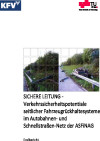
Run off accidents with personal injuries are the second most frequent type of accidents on the ASFiNAG road network. Road Restraints are an important instrument to reduce accident severity. For that reason the efficiency of these systems was analysed, in order to insure an efficient road maintenance regarding infrastructure costs and to reduce furthermore the severity of these accidents.
DI Manuel Pröll, DI Bernd Strnad, DI Dr.techn. Ernst Tomasch
Publisher: BMVIT
German, 102 pages
Publication Downloads
Shear area model - Mechanically consistent shear area-model for existing bridges without or with small lateral force reinforcement
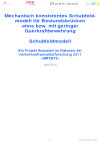
Within the scope of this research project a mechanically consistent model for the shear resistance of bridges without or low shear reinforcement was developed.
Dipl.-Ing. Patrick Huber, Univ.-Prof. Dr.Ing. Johann Kollegger, Univ.-Prof. Dr.Ing. Viet Tue Nguyen, Dr.-Ing. Duc Tung Nguyen
Publisher: BMVIT
German, 251 pages
Publication Downloads
RISKANT – Risk model for the analysis of accidents with stationary obstacles on highways und expressways
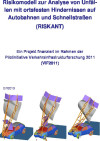
The objective of the RISKANT study was the development of a risk model for crashes with stationary obstacles along the road.
Priv.-Doz. DI Dr. Peter Maurer, DI Christian Stefan, DI Rainer Stütz, DI Dr. Ernst Tomasch, DI Peter Luttenberger, DI Christoph KleinN, Thomas Pistotnik
Publisher: BMVIT
German, 158 pages
